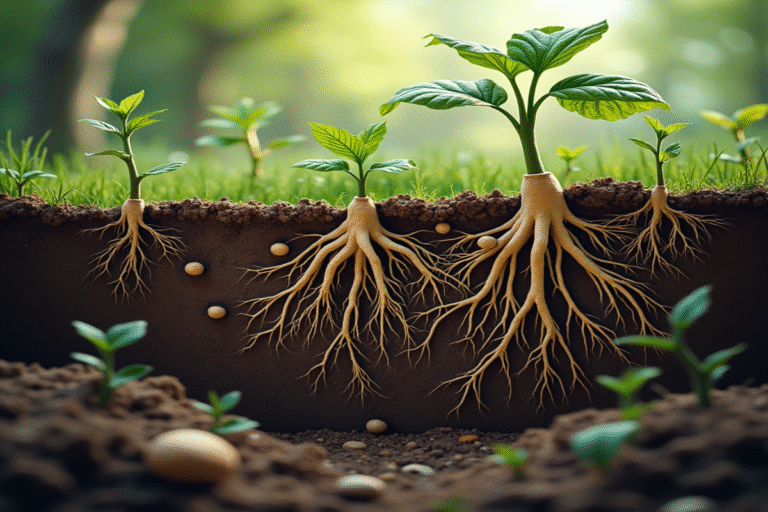Beneath the soil of nearly every healthy ecosystem lies an intricate network that science has only recently begun to fully appreciate. It’s a hidden partnership so fundamental to plant life that without it, our planet’s forests, grasslands, and even agricultural systems would be dramatically different—perhaps even nonexistent.
The Underground Alliance: Mycorrhizal Fungi
Did you know that over 90% of land plants form symbiotic relationships with fungi? These relationships, called mycorrhizae (from Greek “myco” meaning fungus and “rhiza” meaning root), represent one of nature’s most successful partnerships—one that has existed for more than 400 million years, helping plants colonize land in the first place.
The partnership works like this: fungi extend their thread-like structures called hyphae (collectively forming a mycelium) from plant roots into the surrounding soil. These fungal networks essentially become extensions of the plant’s root system, but with a crucial difference—fungal hyphae are much thinner than plant roots, sometimes just 1/60th the diameter.
Nature’s Most Impressive Root Multiplier
This size difference creates a stunning advantage. A single teaspoon of healthy soil can contain up to 8 miles of fungal hyphae. When connected to plants, these microscopic threads can increase the root surface area by 100 to 1,000 times. Imagine suddenly having a thousand times more hands to gather resources—that’s what fungi provide to plants.
The mycelial network acts as a living interface between plant and soil, dramatically expanding the volume of soil from which nutrients can be absorbed. But fungi do more than just reach further—they are active miners and chemists as well.
Chemical Wizards of the Soil
Fungi secrete powerful enzymes that can break down complex organic matter and minerals that would otherwise remain inaccessible to plants. These enzymes can:
- Dissolve phosphorus compounds bound to soil particles
- Extract nitrogen from decaying organic matter
- Access micronutrients like zinc and copper from mineral sources
- Break down rock particles to release potassium and other elements
Perhaps most impressively, certain mycorrhizal fungi can actually “mine” rocks, boring tiny holes into mineral surfaces by secreting organic acids. Under a microscope, scientists have observed these microscopic tunnels—evidence of fungi’s remarkable ability to extract nutrients from seemingly impenetrable sources.
The Underground Economy: Trading Carbon for Nutrients
This isn’t a one-way relationship. In exchange for these nutrient-gathering services, plants provide fungi with carbon-rich compounds produced through photosynthesis. Up to 30% of all the carbon fixed by a plant can be transferred to its fungal partners. This creates what scientists now call the “wood wide web”—a vast underground trading network where resources are shared.
Recent research has revealed that this network can even connect different plants. Through shared fungal connections, trees can share resources with their seedlings, potentially helping them survive in low-light conditions beneath the forest canopy. Some studies suggest that older, larger “mother trees” may even preferentially share resources with their own offspring.
Specialized Fungi for Different Conditions
Nature has evolved different types of mycorrhizal relationships for different environments:
Ectomycorrhizal fungi form sheaths around tree roots without penetrating the cells. These partnerships dominate in temperate and boreal forests, helping trees like pines, oaks, and birches thrive in nutrient-poor soils.
Arbuscular mycorrhizal fungi actually penetrate root cell walls, forming branched structures called arbuscules inside living plant cells. These ancient partnerships help most herbaceous plants, grasses, and tropical trees access nutrients.
Ericoid mycorrhizae help plants in the heather family thrive in acidic, nutrient-poor environments like bogs and heathlands, where other plants struggle to survive.
Applications: From Forest Restoration to Sustainable Agriculture
Understanding these relationships has revolutionary implications. Reforestation projects now routinely inoculate seedlings with appropriate mycorrhizal fungi, dramatically improving survival rates. In agriculture, mycorrhizal inoculants can reduce the need for phosphorus fertilizers by 20–50% while improving plant health and drought resistance.
Perhaps most fascinating is how these fungi help build healthy soil. The protein glomalin, produced by arbuscular mycorrhizal fungi, may be responsible for storing up to 30% of all the carbon in soil worldwide, playing a crucial role in climate regulation.
Next time you walk through a forest or garden, remember: you’re stepping above an invisible network of fungal connections that make plant life as we know it possible. This hidden partnership beneath our feet represents one of nature’s most elegant solutions to the challenge of survival—a microscopic marvel that helps sustain all terrestrial life.





